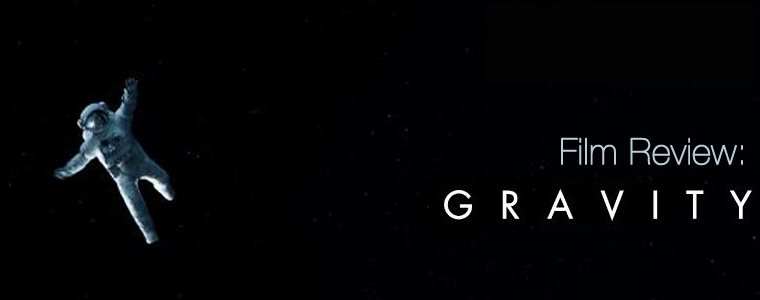The Glorious Terror of Space
by Andrew Collins
Director Alfonso Cuarón’s IMDB biography says that he has always wanted to be two things: a director and an astronaut. No surprise, then, that he made Gravity. The film tells the survival story of astronaut Matt Kowalski (George Clooney) and medical engineer Ryan Stone (Sandra Bullock) after their mission to upgrade a satellite telescope goes horribly awry. The resulting story is simple: Astronauts try to get back to earth after their shuttle is disabled by satellite debris—that’s it. But Cuarón makes it so much more.
It begins in the moment, at the tail-end of a shuttle mission as Ryan is making the final adjustments to a telescope. Matt circles her in his jetpack, chatting about life down on earth and remarking on how close he will be to breaking the record for longest time spacewalking before he retires after this mission. Just as we get comfortable, disaster strikes when a cloud of debris shreds the shuttle beyond use, kills the crew, and sends Ryan spinning into space. As Matt goes after her, the journey begins. The film alternates between the heart-pounding urgency of the situation — oxygen running out, the debris cloud returning– and quiet moments, suspended two hundred miles above the earth. In the process, it shows us why these two little specks of humanity matter.
Gravity sucks us in most by molding a three dimensional protagonist: Bullock’s Ryan Stone. The struggle to survive births an existential crisis for a heartbroken woman fighting nearly impossible odds. You lost your four-year-old daughter, Matt tells her at one point and, (I paraphrase) life doesn’t get much harder than that. It would be so easy to give up right now. If you’re going to get home, you have to find a reason to go back there – you have to find a way to keep living beyond tragedy. At the very least, he says, you’ll have a “hell of a story to tell.” The possibility of such a story gives Ryan fresh resolve – even a faith, of sorts, as she finds herself praying for the first time in her life.
Cuarón presents the setting for this human struggle masterfully. Gravity’s soundtrack and sound effects are built on low notes and thuds as the film walks the fine line between being technically correct (there is no sound in space) and using powerful theatrical effects to hit viewers in the gut with the cold, brute magnitude of the cosmos. There’s a certain raw horror in watching a space station silently explode behind Ryan in a hail of satellite shrapnel – the coldest, most impersonal of killers. Up here, no one can hear you scream, and no one is coming to save you. Multiple times, as Ryan yells in frustration inside a space station or escape pod, the camera cuts abruptly outside to the deafness of space, accentuating the futility and loneliness of her striving.
Visually, Gravity captures the terrifying wonder of space as experienced in orbit above the earth, maximizing the sensory limits of IMAX by filling the screen with brilliant colors and untainted light. Beauty floods the scene all around Matt and Ryan, catching us up in the glorious rapture of creation that simply screams life. “Isn’t it beautiful,” says Matt, ever a bastion of stabilizing calm, humor, and hope, as the sunrise explodes across the curve of the earth. The danger does nothing to diminish any of it. In the hands of Cuarón, even a disintegrating space station becomes glorious as it burns out in bright red streaks above the shimmery green northern lights – all as Ryan starts to plunge to what very well may be her death.
Herein lies a powerful tension. Against the backdrop of such majesty, the survival fight plays out before us in an atmosphere that is, frankly, nonexistent. In an inversion of the man versus nature plot, where humans struggle against oppressive external elements or wild creatures, Gravity pits a pair of astronauts against the nothingness — where something as simple as one’s own inertia becomes one of the greatest threats to survival. This gives Gravity an engrossing vigor, because perhaps the only thing more frightening than a monstrous interloper is the face of the abyss. That is what space is, after all – a vast expanse of nothingness stretching forever into more nothingness. Here Ryan encounters the existentialist experience in its physical incarnation as she dangles from an orbiting piece of metal and oxygen, often just a hand’s grip away from spinning eternally, hopelessly, into the black.
Thus, Gravity becomes a metaphor for the human experience. When we honestly look into our lives we soon find ourselves floating through a world that provides no immediate sense of meaning and purpose. Instead of just minutes of air to breathe, we have years — but our days are numbered nonetheless. Ryan aims to get to a space station, a small refuge where she can find more air to preserve her life for another hour or two. But more importantly, she seeks the space station because it holds the hope of salvation — an escape pod that can transport her from her current world, which is hostile to her existence, to one created for life, her true home.








